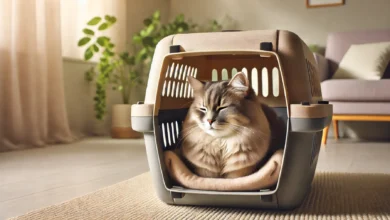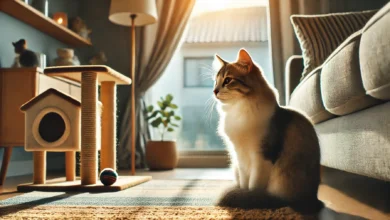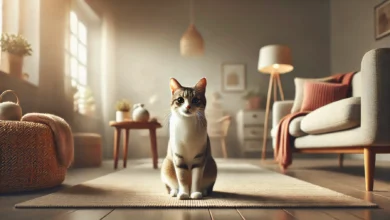How to Train Cats for Car Travel Safety
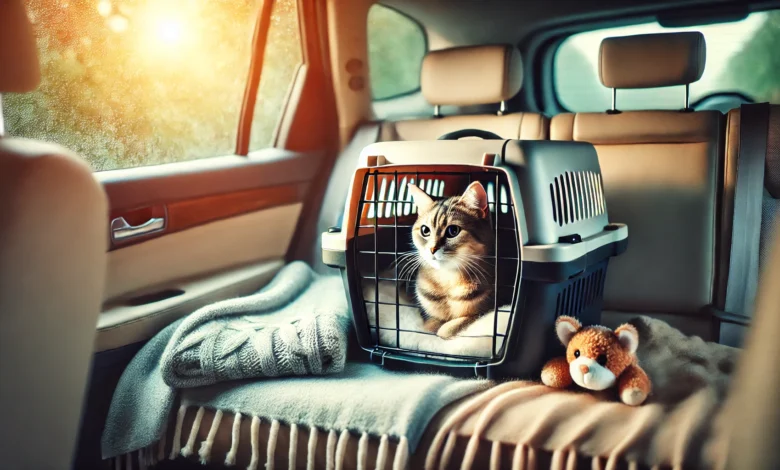
Traveling with cats can be a challenge, and it often involves car travel.
While dogs easily adjust to being driven around in cars, most cats do not take to it naturally.
To your cat, a car presents an unfamiliar situation with new sounds and smells—all potentially anxiety-provoking or even frightening.
With proper training and preparation, however, you can help your feline friend feel safe and relaxed while traveling by car.
This guide will take you through essential tips to prepare your cat for car travel, from selecting the most appropriate carrier to creating a comfortable, non-stressful atmosphere within the car.
Whether it’s a long road trip or just a quick visit to the vet, these tips will ensure your cat’s safety and comfort every step of the way.
Table of Contents
Preparing Your Cat for Car Travel
It takes planning and patience to get your cat ready for car travel.
Cats are creatures of habit and can be sensitive to changes, so helping them feel at ease in a moving vehicle may take time.
However, with some simple steps and a positive introduction to the car environment, it’s possible to make car travel more tolerable for your cat.
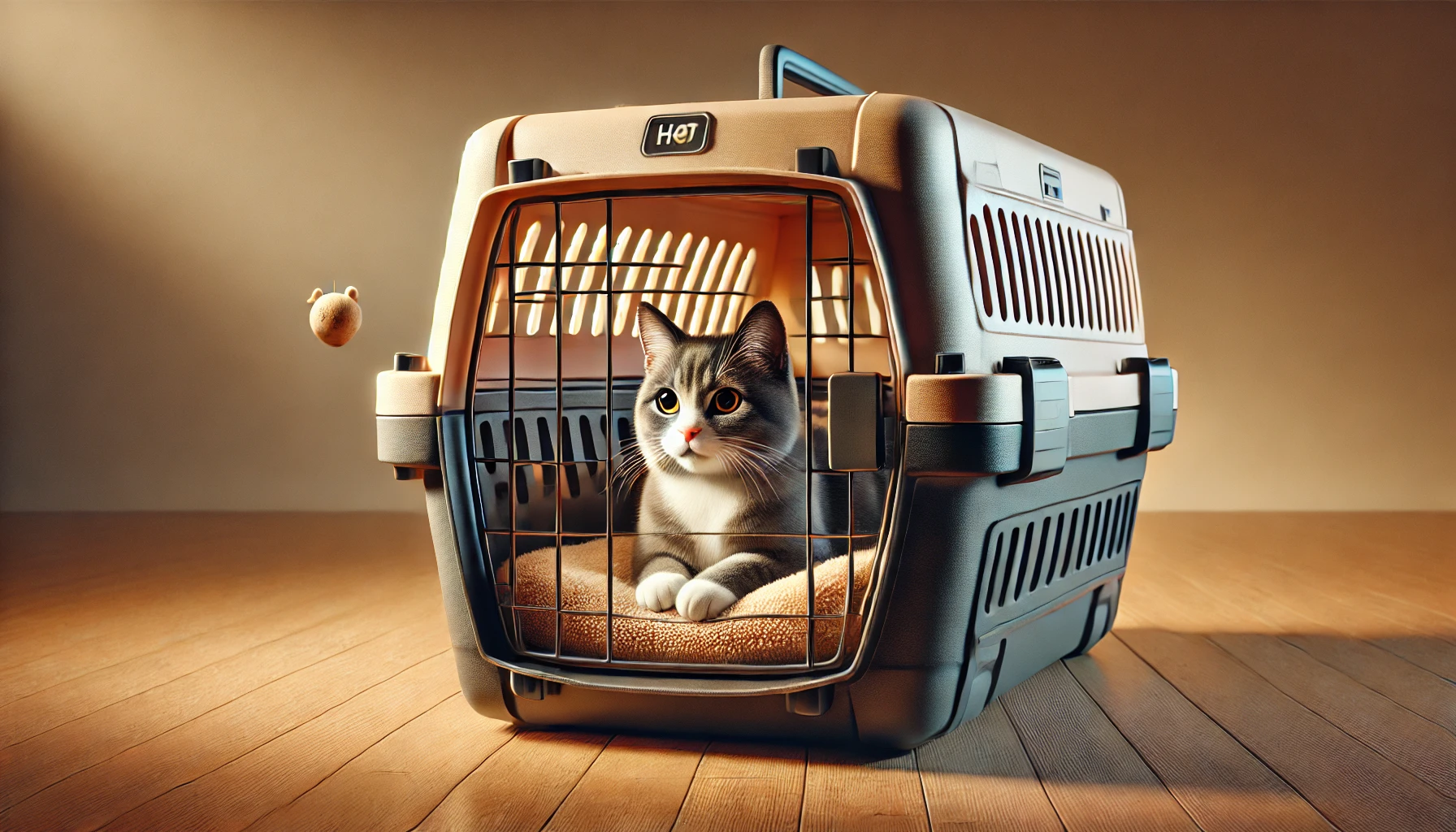
Choosing the Right Carrier for Your Cat
The first step in preparing your cat for car travel is choosing a safe, comfortable carrier.
A well-designed carrier not only keeps your cat secure but also provides a place where they can retreat to feel safe and less vulnerable.
When choosing a carrier, select one that allows enough room for your cat to sit, stand, and comfortably shift positions.
Hard-sided carriers are often more secure for car travel, as they offer better protection in case of sudden stops or sharp turns.
- Size and Comfort: Choose a carrier large enough for your cat to move comfortably, but snug enough to prevent excessive movement.
- Ventilation: Ensure that the carrier has proper ventilation to keep your cat cool and comfortable during travel.
- Easy Access: Select a carrier with multiple openings or one that allows you to reach in and comfort your cat if needed.
Take time to acclimate your cat to the carrier at home before the trip.
This helps create a positive association with the carrier, making them feel more secure during car travel.
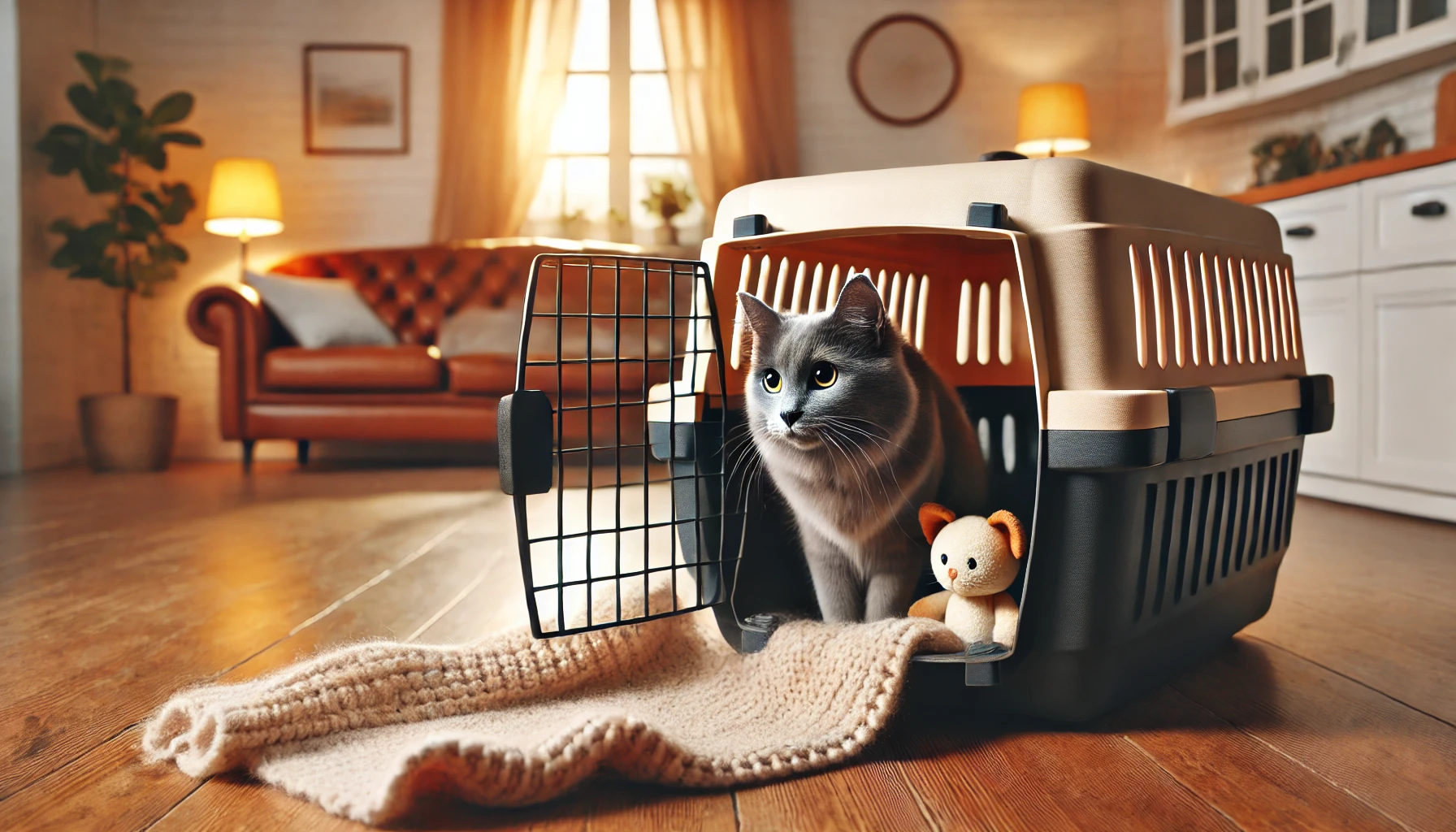
Introducing Your Cat to the Carrier
Allowing your cat to become familiar with the carrier gradually and positively can help reduce their anxiety about car travel.
Start by placing the carrier in a comfortable, familiar spot in your home.
Keep the door open, allowing your cat to enter and exit freely.
Consider adding a soft bed or towel, a favorite toy, or even a few treats inside.
- Use Treats and Toys: Place treats or toys inside the carrier to encourage your cat to enter willingly.
- Practice Short Stays: Once your cat is comfortable entering the carrier, close the door briefly while they’re inside, gradually increasing the duration.
- Leave the Carrier Out: Keep the carrier accessible in your home so your cat can explore it at their own pace without feeling rushed or pressured.
By introducing the carrier as a positive space, you’re setting the foundation for smoother car travel.
Over time, your cat will come to view the carrier as a place of safety, even outside the home environment.
Preparing your cat for car travel involves planning, patience, and creating a positive association with the car. With these steps, you can help your cat feel more at ease on the road.
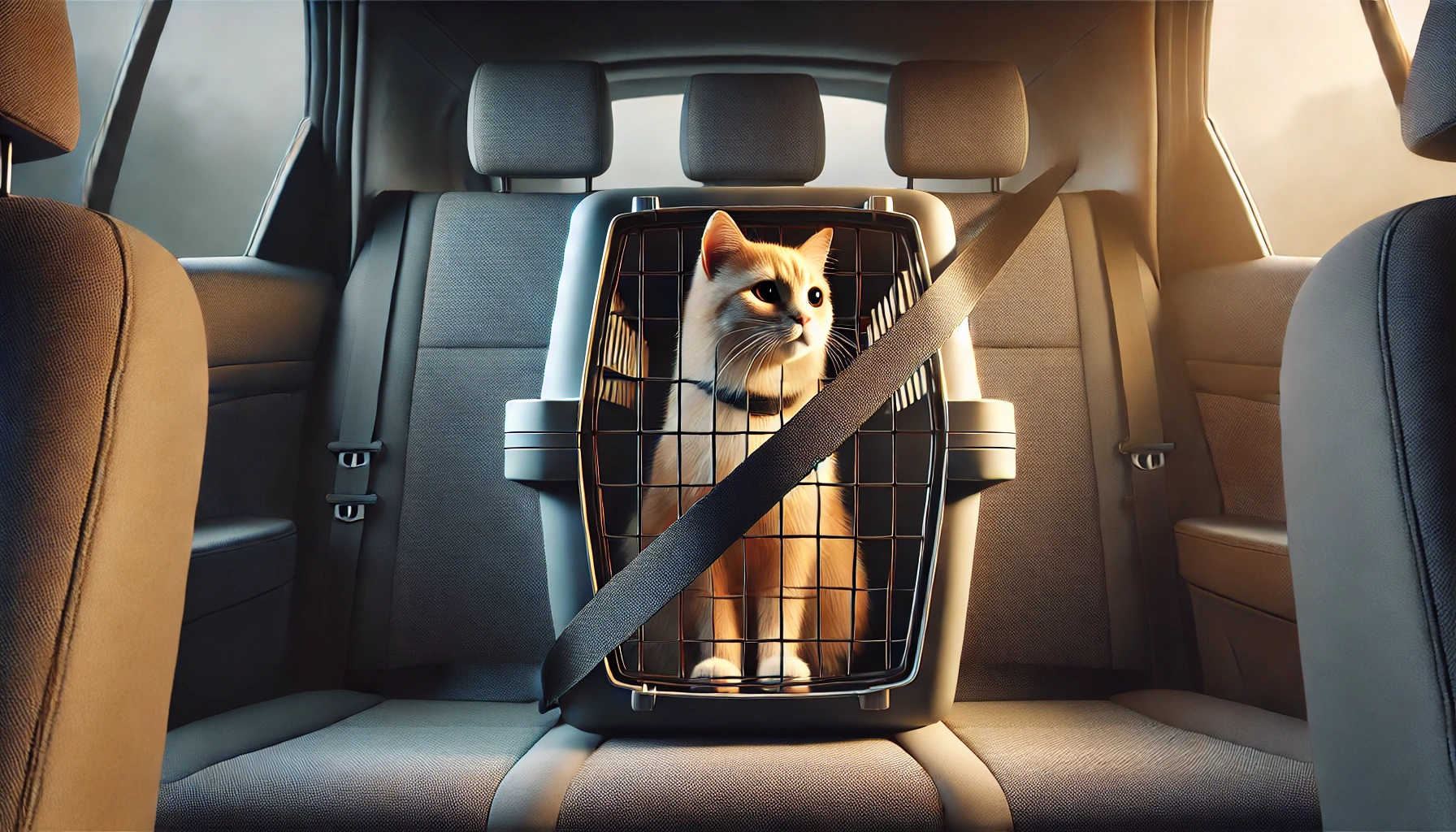
Safety Issues for Cats During Car Travel
Safety concerns for your cat should be kept in mind during car travel, as unrestrained pets face various risks in moving vehicles.
Cats can become panicked and may try to wander around the vehicle, which can lead to driver distraction and potential accidents.
By following some basic safety measures, you can make car travel less hazardous for both you and your cat.

Safely Securing the Carrier in the Car
One of the most important aspects of traveling by car with your cat is securing their carrier correctly.
A carrier that moves around can increase your cat’s anxiety and also pose a risk in case of sudden stops or turns.
Position the carrier in a stable place, preferably on the back seat, and secure it using a seatbelt.
Many carriers have built-in loops or straps that allow you to secure them with a seatbelt.
- Positioning: Place the carrier on the rear seat, as it is usually safer than the front.
- Using Seatbelts: Secure the carrier with a seatbelt, either through loops or over the top, to prevent it from moving.
- Avoiding Front Airbags: Never place the carrier in the front seat, as cars with airbags can injure your cat due to the force involved in deployment.
Securing the carrier properly not only keeps your cat much safer but also reduces their stress by preventing unnecessary movement.
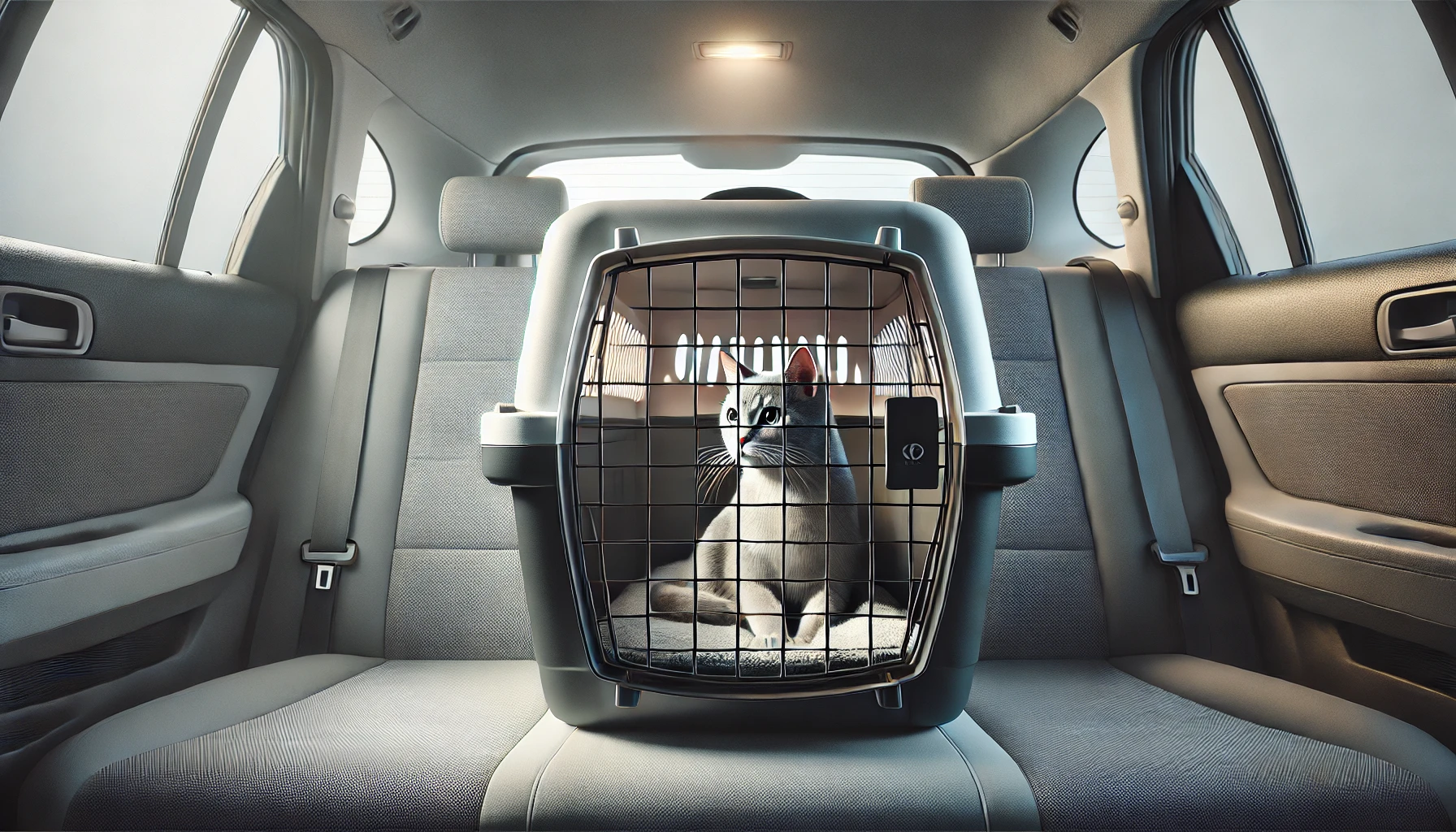
Temperature and Ensuring Proper Ventilation
Cats are sensitive to temperature changes, and their carriers can quickly become too hot or too cold.
Keep your cat well-ventilated and maintain a comfortable temperature inside the car.
Avoid direct sunlight, as car interiors can overheat even on mild days.
- Windows and Ventilation: Keep a window slightly open for fresh air circulation, but avoid direct drafts on the carrier.
- Monitoring Temperature: Regularly check the car’s temperature to ensure your cat is comfortable.
- Avoiding Overheating: If you need to stop briefly, never leave your cat in the car alone, as cars can quickly overheat, posing a serious hazard.
Keeping your cat comfortable and relaxed through proper temperature regulation and ventilation is essential for a safe and stress-free trip.

Dangers of Driving Distractions
It’s important to keep your attention on the road and minimize distractions from your cat during car travel.
Cats may meow or show restlessness, but it’s crucial to stay calm and avoid reaching into the carrier or turning around while driving.
If your cat becomes too distressed, pull over safely to comfort them before resuming your journey.
- Plan for Minimal Stops: Reduce the number of stops to avoid prolonged stress for your cat.
- Calming Tools: Consider using pheromone sprays or calming collars to help keep your cat relaxed.
- Avoid Loud Music: Maintain a calm environment by avoiding loud music or sudden noises in the car.
Minimizing distractions helps make the journey safer and less stressful for both you and your cat.

Planning for Emergency Stops
When traveling with a cat, it’s wise to be prepared for emergencies.
Cats can become anxious or sick if they aren’t used to car travel, so unscheduled stops may be necessary.
Bring a small kit of travel essentials, like wet wipes, extra towels, a small water bowl, and some food, in case you need to calm or clean your cat unexpectedly.
- Keep Supplies Handy: Bring a small travel kit with items like wet wipes, towels, and extra food.
- Know Safe Stop Areas: Plan your route to include rest stops or pet-friendly places where you can safely pull over if needed.
- First Aid Preparedness: Carry a basic first aid kit with pet-safe items in case minor issues arise.
With a bit of planning, you’ll be ready for unexpected stops, ensuring a safer and more comfortable journey for your cat.
For a safe trip, always keep your cat secured in the carrier and prevent them from roaming freely inside the car. Driver distractions can be dangerous.
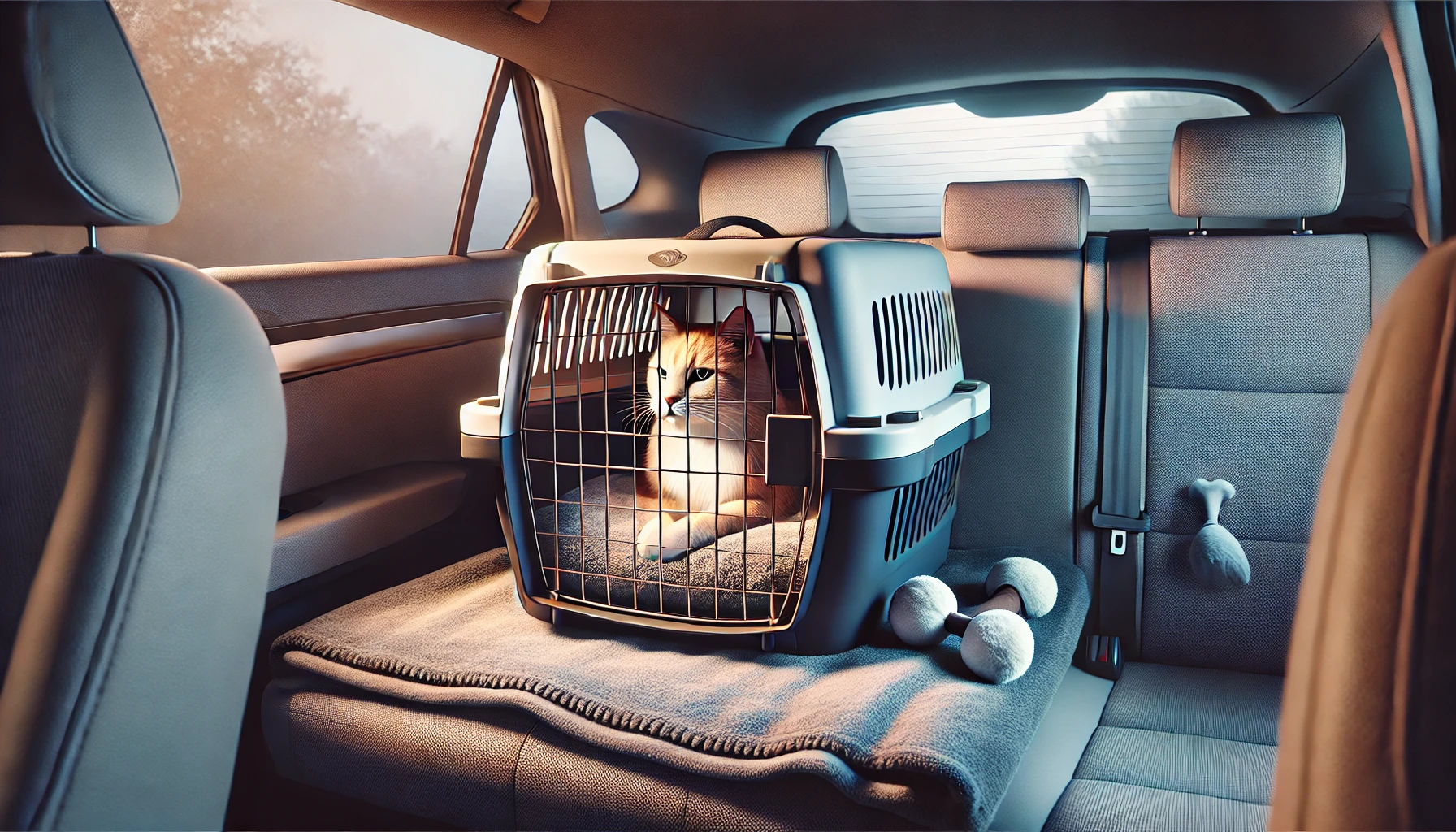
Minimizing Stress and Anxiety in Cats During Travel
Many cats are sensitive to changes in their surroundings and to motion, which can make car travel stressful.
Minimizing anxiety during the journey is essential for your cat’s safety and comfort.
With some preparation, you can help make car rides more comfortable and less stressful for your cat.
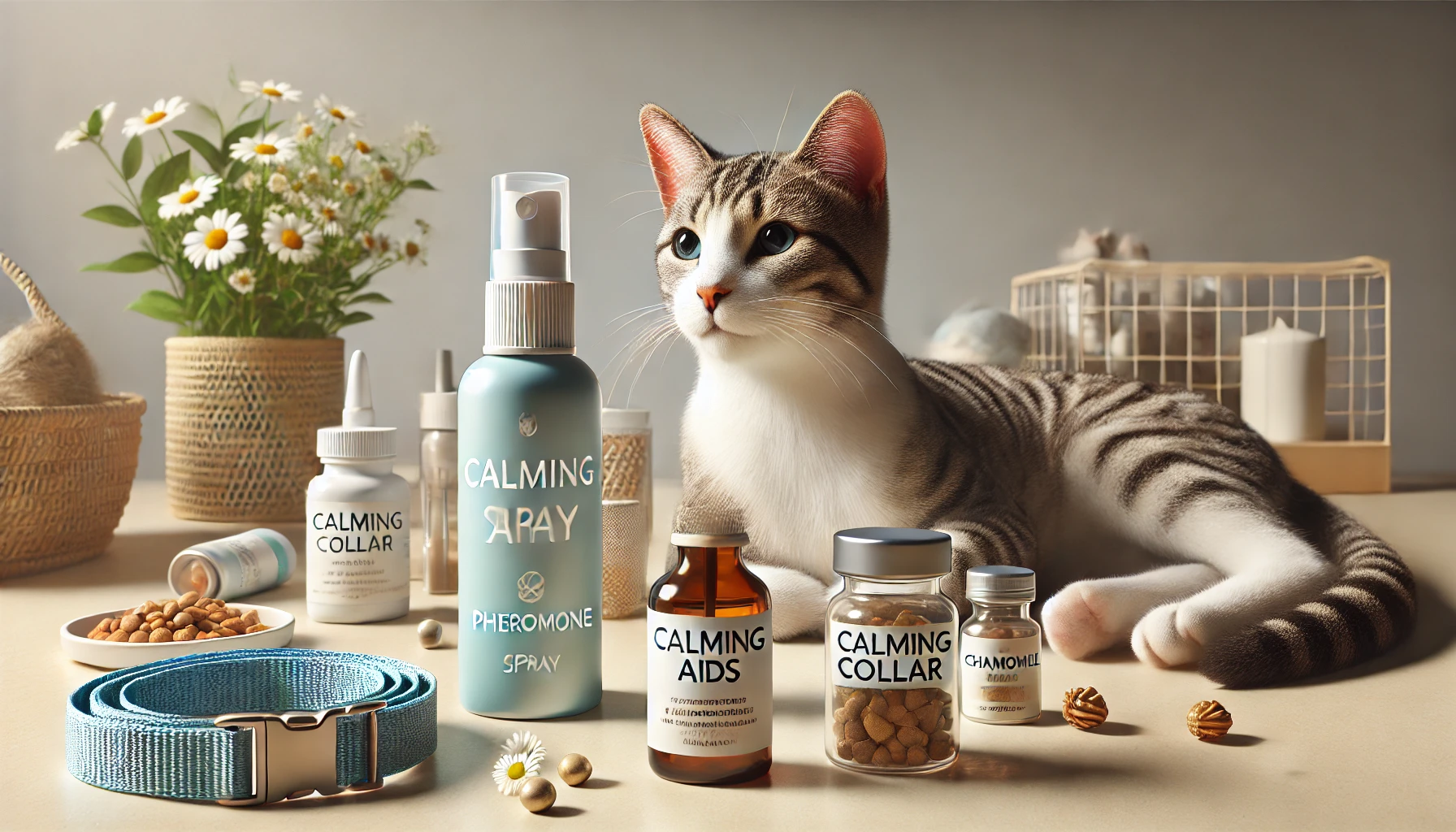
Cat Calming Aids
Calming aids like pheromone sprays and collars can alleviate anxiety in cats while traveling.
These products emit synthetic versions of natural pheromones that cats associate with comfort and security.
You can spray a calming pheromone in the carrier a few minutes before placing your cat inside, or use a calming collar that provides continuous support throughout the journey.
- Pheromone Sprays: Spray a synthetic pheromone, such as Feliway, in the carrier 10 to 15 minutes before travel to create a comforting environment.
- Calming Collars: Consider using a calming collar that releases pheromones slowly over time to help keep your cat calm.
- Natural Supplements: Certain natural supplements, like chamomile or L-theanine, may also help reduce anxiety. Be sure to consult your veterinarian before using any supplement.
These calming aids can create a more relaxed atmosphere for your cat, making car travel less stressful.
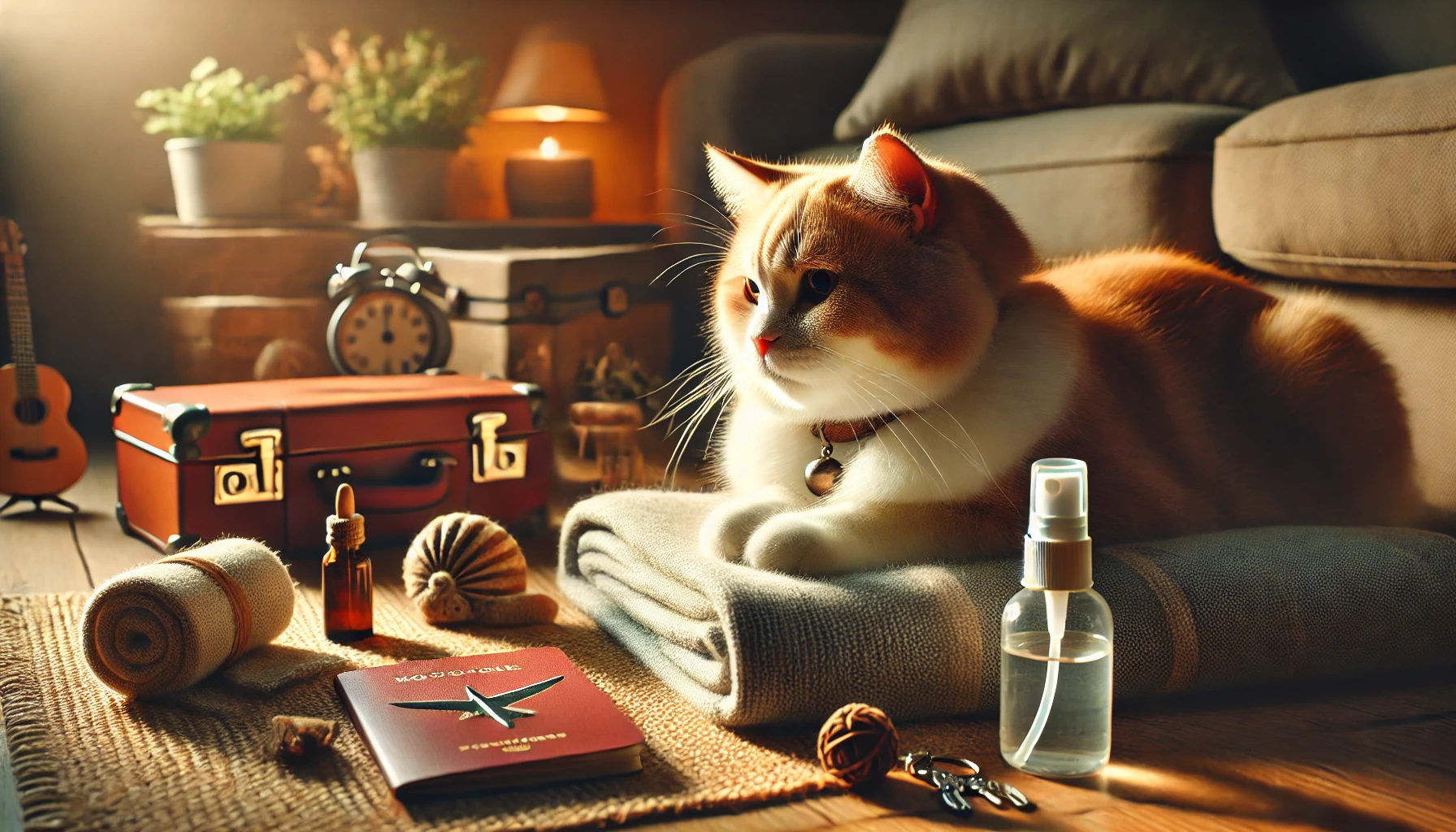
Keeping Your Cat Calm Before the Journey
Helping your cat stay calm before the trip can set the stage for a smoother journey.
Try to keep your cat’s routine as normal as possible leading up to the trip.
When possible, engage your cat in light play to reduce energy levels and prepare them for the confined environment of a carrier.
- Stick to a Schedule: Avoid sudden changes in your cat’s routine or environment before the trip, as this can add stress.
- Playtime: Lightly play with your cat before the trip to help them expend energy and relax.
- Feeding Schedule: Feed your cat a light meal a few hours before travel, as a full stomach may contribute to motion sickness.
By maintaining a calm and predictable pre-travel environment, you reduce the chance of an anxiety-filled car ride.

Understanding Common Travel Anxiety Triggers
Recognizing and managing your cat’s travel anxiety triggers can help keep them calm.
Some cats may be affected by engine noise, road bumps, or even passing scenery.
Identify potential triggers and make adjustments to the environment as needed.
- Engine Noise: Start the car engine a few minutes before loading your cat to allow them time to adjust to the sound.
- Minimize Visual Stimuli: Cover the carrier with a light cloth or towel to limit your cat’s view of passing scenery if this triggers anxiety.
- Soft Music: Play gentle music at a low volume to mask outside noises and create a soothing atmosphere.
By identifying these triggers, you can take steps to significantly reduce anxiety and ensure a more comfortable travel experience for your cat.
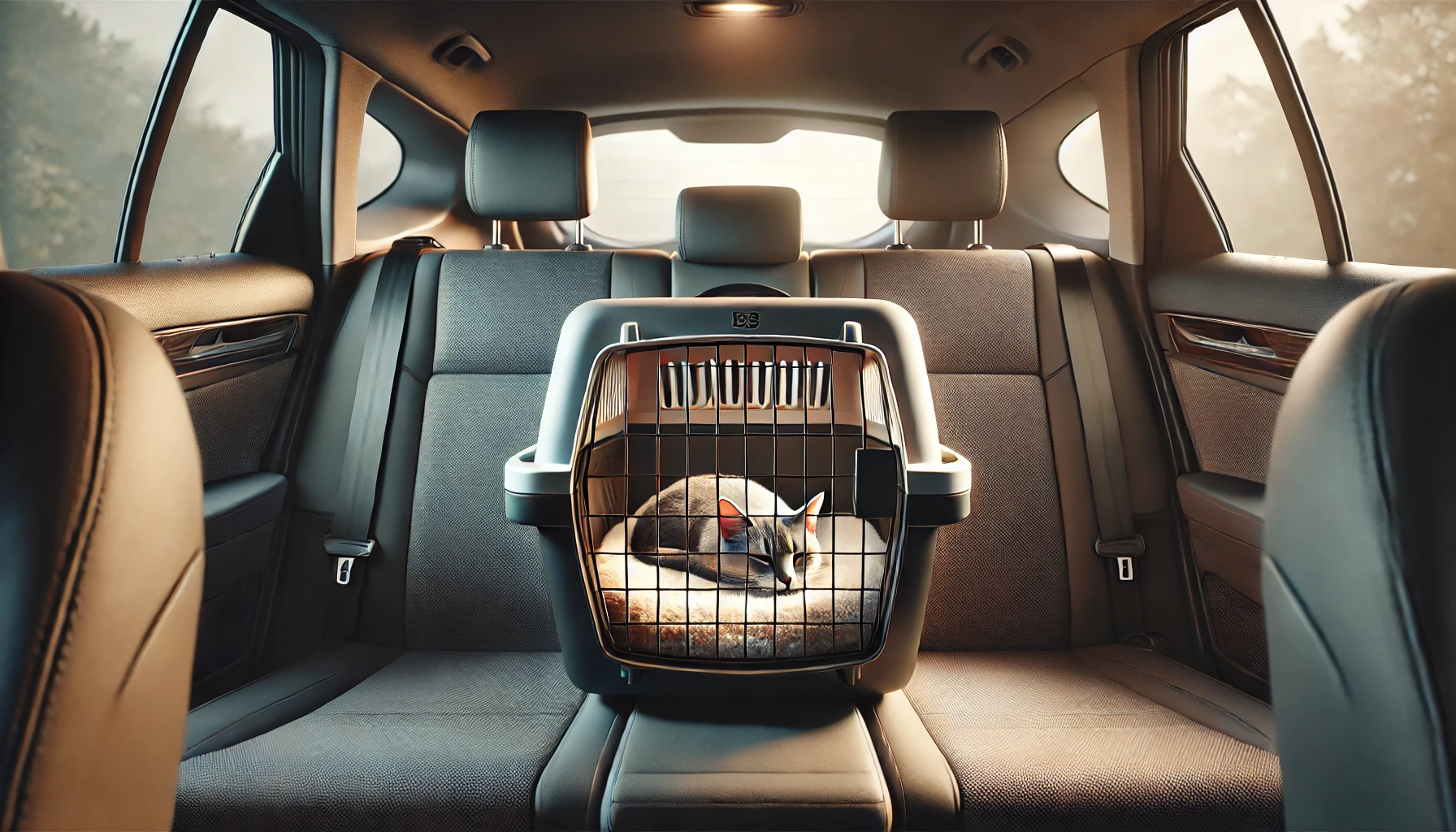
Creating a Quiet and Peaceful Environment in the Car
A calm environment in the car is crucial to reducing stress for your cat.
Avoid loud music or sudden noises, and maintain smooth, steady driving.
A quiet, stable environment will help reassure your cat, allowing them to relax during the journey.
- Quiet Atmosphere: Keep noise levels low; avoid loud music or unnecessary sounds.
- Stable Driving: Drive smoothly, avoiding sudden starts and stops to help your cat feel more secure.
- Comfortable Carrier Setup: Place soft bedding or a blanket with your scent in the carrier to add familiarity and security.
Creating a calm and quiet environment can make a significant difference in your cat’s comfort, helping them feel safe and more at ease during car travel.
Help your cat stay calm by using calming aids like pheromone sprays and maintaining a quiet car environment.

Training Tips for Long-Distance Car Trips
Long-distance car trips with a cat demand extra preparation to keep them comfortable, calm, and safe throughout the journey.
Training your cat for longer trips involves helping them become more accustomed to car travel, taking frequent breaks, and ensuring their basic needs are met during the trip.
Here are key tips to help you and your cat handle long road journeys.

Long Trips with Your Cat – How to Prepare
If you’re planning a long road trip, gradually acclimating your cat through shorter practice rides can be very beneficial.
Start with brief drives around the block, then work up to longer rides over time.
This gradual exposure helps your cat get comfortable with car motion and reduces anxiety about longer trips.
- Practice Trips: In the months leading up to a long trip, take your cat on short rides to get them used to car travel.
- Gradual Adjustment: Gradually increase the length of rides to build your cat’s tolerance for longer trips.
- Comfort Essentials: Bring items from home that your cat associates with comfort, such as a familiar blanket or favorite toy, to ease stress during the trip.
Gradual exposure to car travel will help your cat adapt to longer trips, minimizing stress for both of you.

Making Frequent Stops for Breaks
On long trips, be sure to make frequent stops to allow your cat a break from the carrier.
Stop every few hours to check on your cat, offer water, and let them stretch.
These breaks can reduce stress and prevent discomfort.
- Hydration Breaks: Offer your cat fresh water at each stop to keep them hydrated, especially in warm weather.
- Rest Opportunities: Let your cat out of the carrier for a few minutes to stretch and acclimate to the environment.
- Quiet Stop Locations: Use pet-friendly rest stops or quiet areas away from traffic to minimize noise and stress for your cat.
Frequent stops help prevent restlessness and discomfort, making the trip easier for your cat.
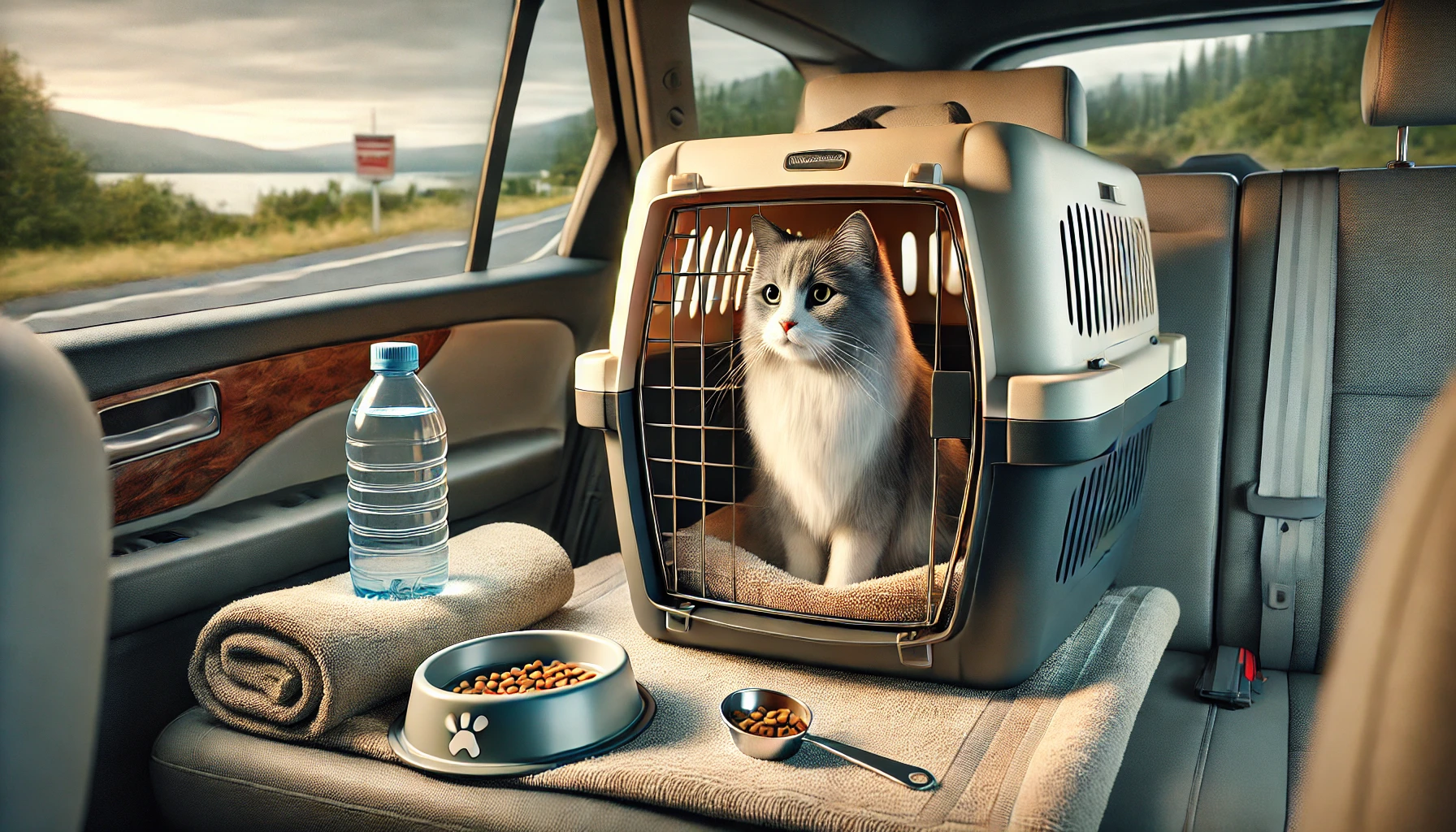
Feeding and Hydrating Your Cat During Travel
Maintaining a balanced feeding and hydration schedule is crucial during long-distance travel.
Feed your cat lightly a few hours before the trip to prevent motion sickness, and bring food and water for longer journeys.
Portable, spill-proof bowls are ideal for feeding and watering your cat during rest stops.
- Light Feeding: Avoid heavy meals before travel to reduce the risk of motion sickness.
- Portable Bowls: Bring spill-proof bowls for food and water to make feeding more convenient during stops.
- Regular Water Access: Offer water at each stop, especially when traveling in hot climates, to keep your cat hydrated.
Keeping your cat well-fed and hydrated helps them stay comfortable and reduces the risk of travel-related stress or illness.
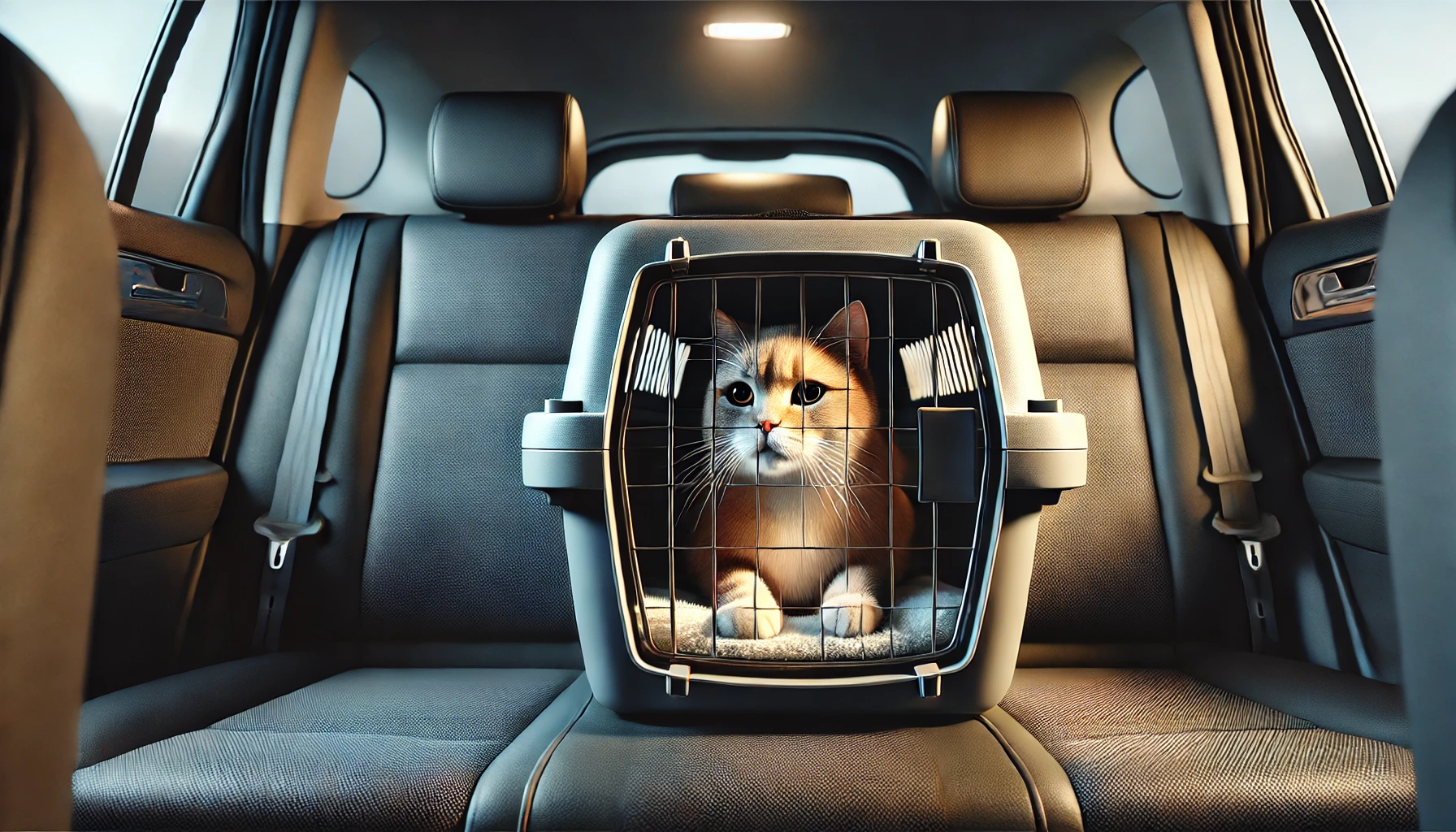
Recognizing Signs of Discomfort in Your Cat
During a long journey, it’s important to monitor your cat for any signs of discomfort or stress.
Signs of distress may include excessive meowing, panting, or scratching at the carrier.
If you notice these signs, consider stopping in a safe place to check if your cat needs food, water, or some time outside the carrier to relax.
- Excessive Meowing: Persistent meowing can indicate stress or discomfort, and may mean your cat needs a break.
- Panting: Cats may pant when they’re stressed or overheated; check the temperature and cool down the car if necessary.
- Scratching or Restlessness: If your cat is scratching at the carrier or appears restless, consider providing a comforting item or taking a break.
By observing these signs and meeting your cat’s needs as you travel, you can ensure a smoother and more enjoyable long-distance car trip.
Acclimate your cat to longer car trips gradually by practicing with short drives and bringing comfort items from home.

Aftercare: Helping Your Cat Settle Once Back from the Trip
After a car trip—especially a long one—it’s important to help your cat readjust to being back home.
Cats can show signs of disorientation or stress after travel, and providing a quiet, familiar environment aids in their transition process.
Here are some major steps to follow to help your cat settle comfortably after a journey.

Allow Time for Your Cat to Readjust at Home
Once you’re back home, allow your cat to re-acclimate to their surroundings.
Avoid overwhelming them with attention, as they may need some time alone to fully settle.
Let your cat decide when they’re ready for interaction.
- Quiet Space: Provide a quiet, familiar space where your cat can rest and decompress after the journey.
- Encourage Exploration: If your cat has been away for an extended time, allow them to gradually explore the house again at their own pace.
- Monitor Behavior: Watch for any lingering signs of stress, such as hiding or excessive grooming, and give them extra time to settle if necessary.
By giving your cat time in a quiet environment, you allow them to rediscover their comfort and sense of safety.
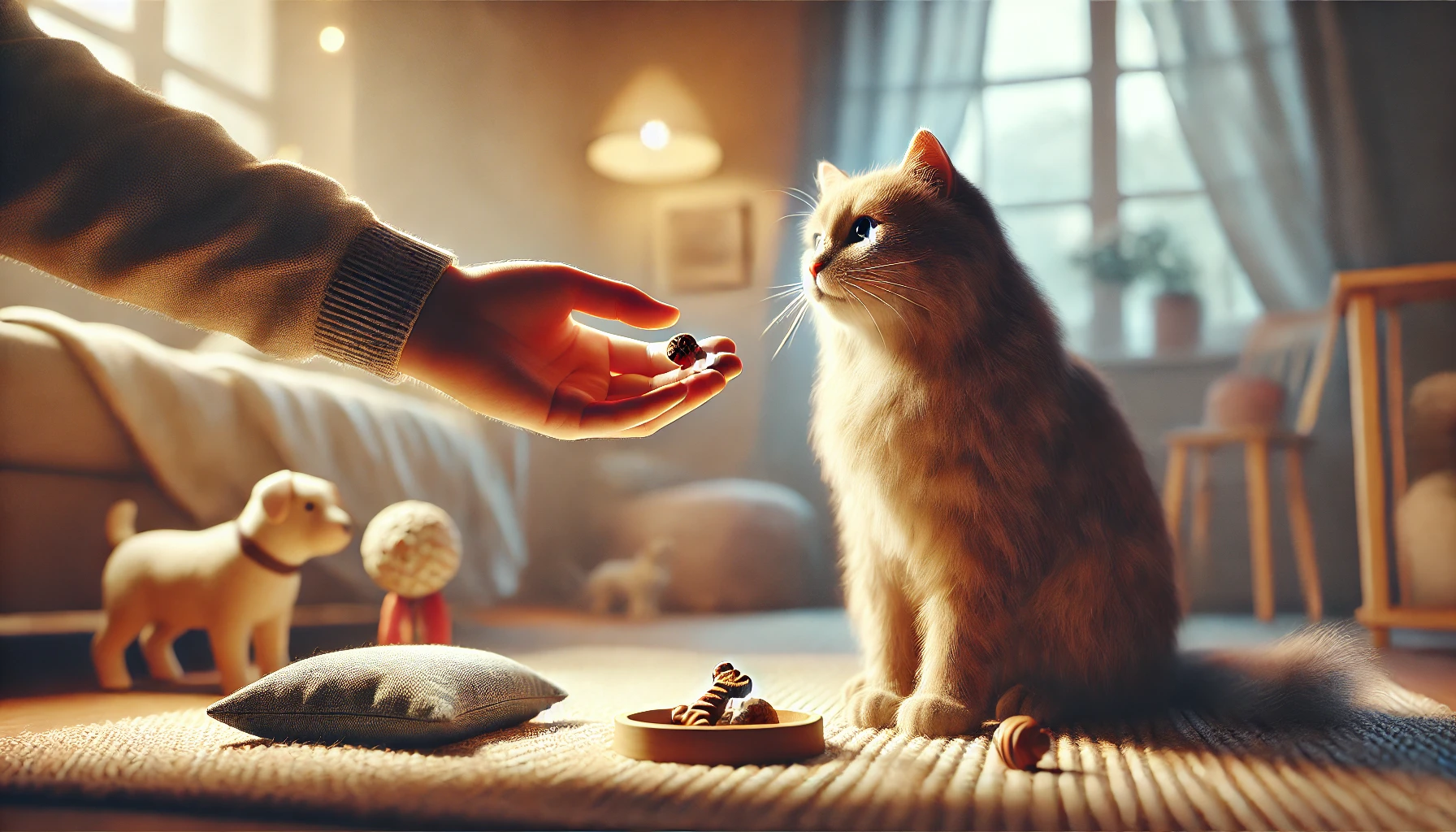
Rewarding and Praising After the Journey
Offering treats and gentle praise helps your cat associate the end of a trip with positive experiences.
Providing a favorite treat or toy can create a sense of comfort and familiarity, reinforcing that travel is safe and can end on a pleasant note.
- Treat Rewards: Give treats to reassure your cat and reinforce a positive end to the travel experience.
- Gentle Praise: Use a calm voice and offer gentle strokes to show appreciation for their patience during the journey.
- Interactive Toys: Bring out a favorite toy to turn any residual stress into fun and relaxation.
These positive reinforcement methods reassure your cat that they are safe and appreciated, making future travels easier.
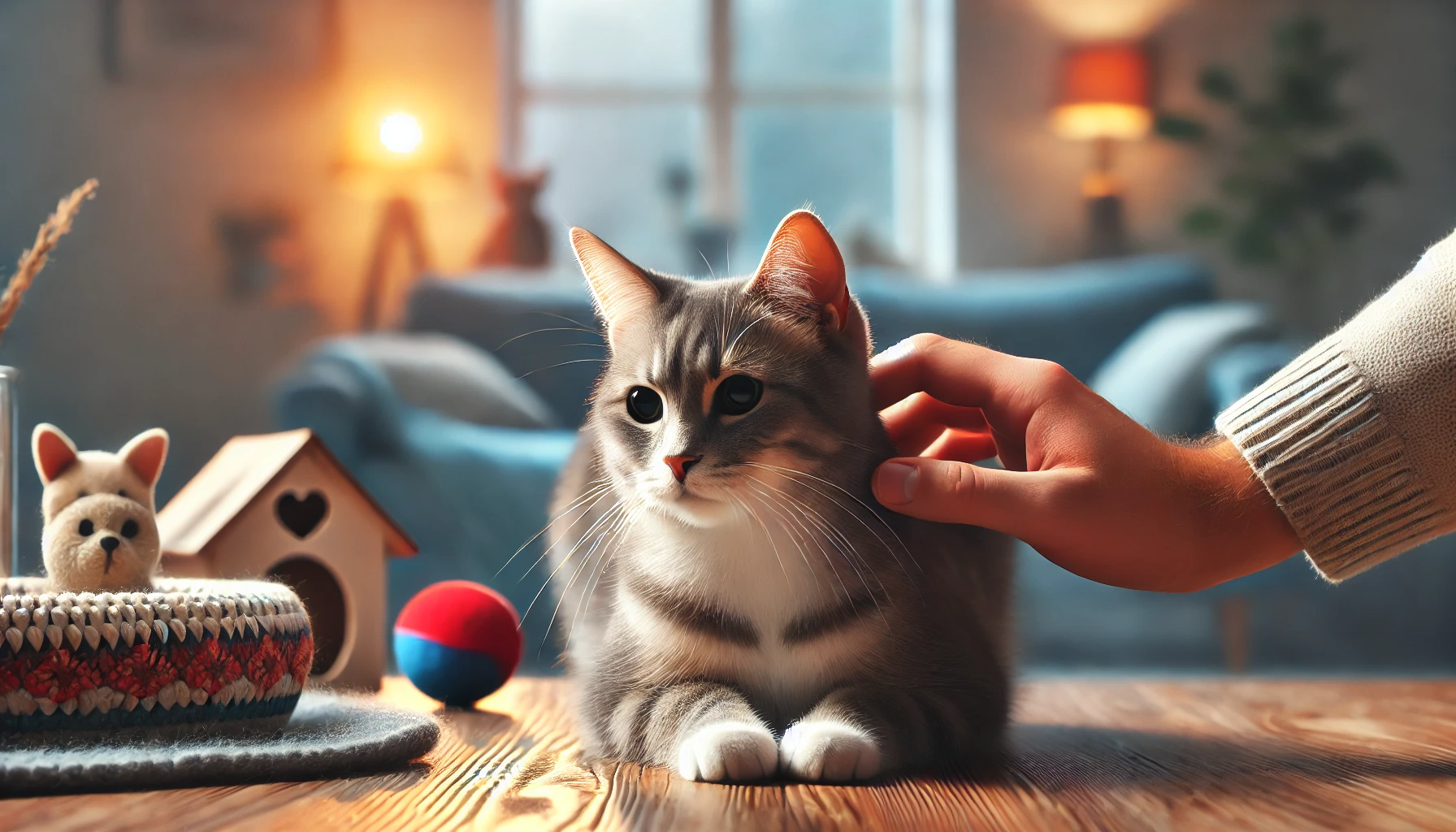
How to Check Your Cat for Signs of Travel Stress
After traveling, monitor your cat for a few days for signs of lingering travel stress, such as hiding, refusing food, or excessive grooming.
These behaviors may indicate that your cat needs more time to feel secure.
If symptoms persist, consult your veterinarian for further advice.
- Monitor Eating Habits: Watch for changes in appetite, as a sudden decrease can be a sign of stress.
- Hiding: If your cat is hiding more than usual, they may still feel anxious and may benefit from a quieter environment.
- Check Grooming Patterns: Excessive grooming or licking can be a sign of stress, so creating a soothing space can help them feel more at ease.
Recognizing these signs and responding to your cat’s needs will help them recover from travel-related stress more quickly.
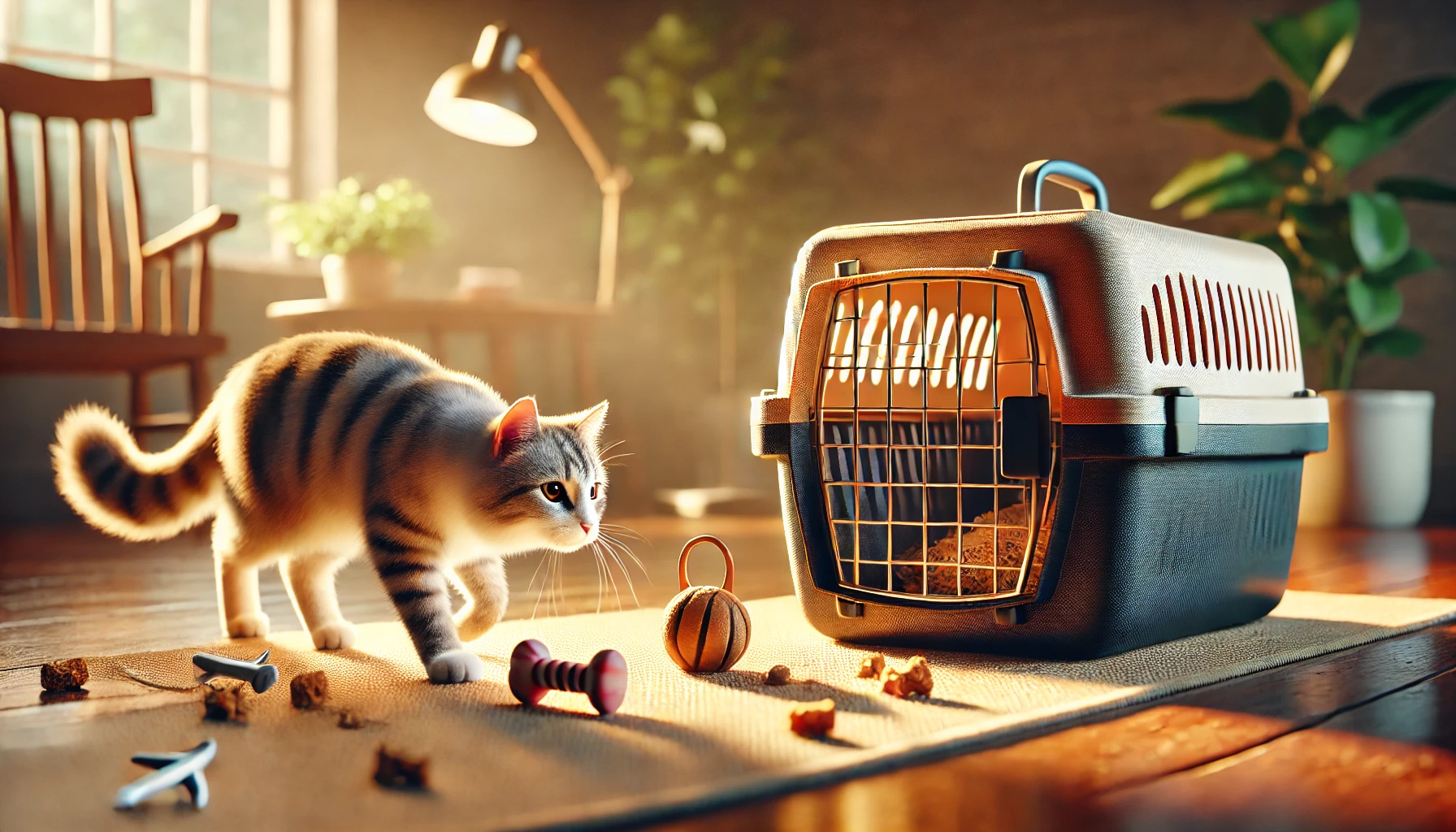
Creating Positive Associations for Future Travels
Helping your cat develop positive associations with travel can make future trips easier.
Use treats, toys, and gentle attention during the post-travel period to reinforce that travel is safe and often leads to pleasant experiences.
Over time, your cat may become more comfortable and less anxious about future trips.
- Use Favorite Treats: Reward your cat with treats after each trip to help them associate travel with positive rewards.
- Maintain Familiar Smells: Place familiar items, like blankets or toys with their scent, in the carrier to create a comforting travel environment.
- Gradual Re-Exposure to Car Travel: Consider taking occasional short drives to reinforce positive travel experiences.
These small steps can make a big difference in helping your cat feel more comfortable with travel in the long run.
After the trip, allow your cat time to adjust to being home. Create a calm space for them and monitor for signs of lingering stress.
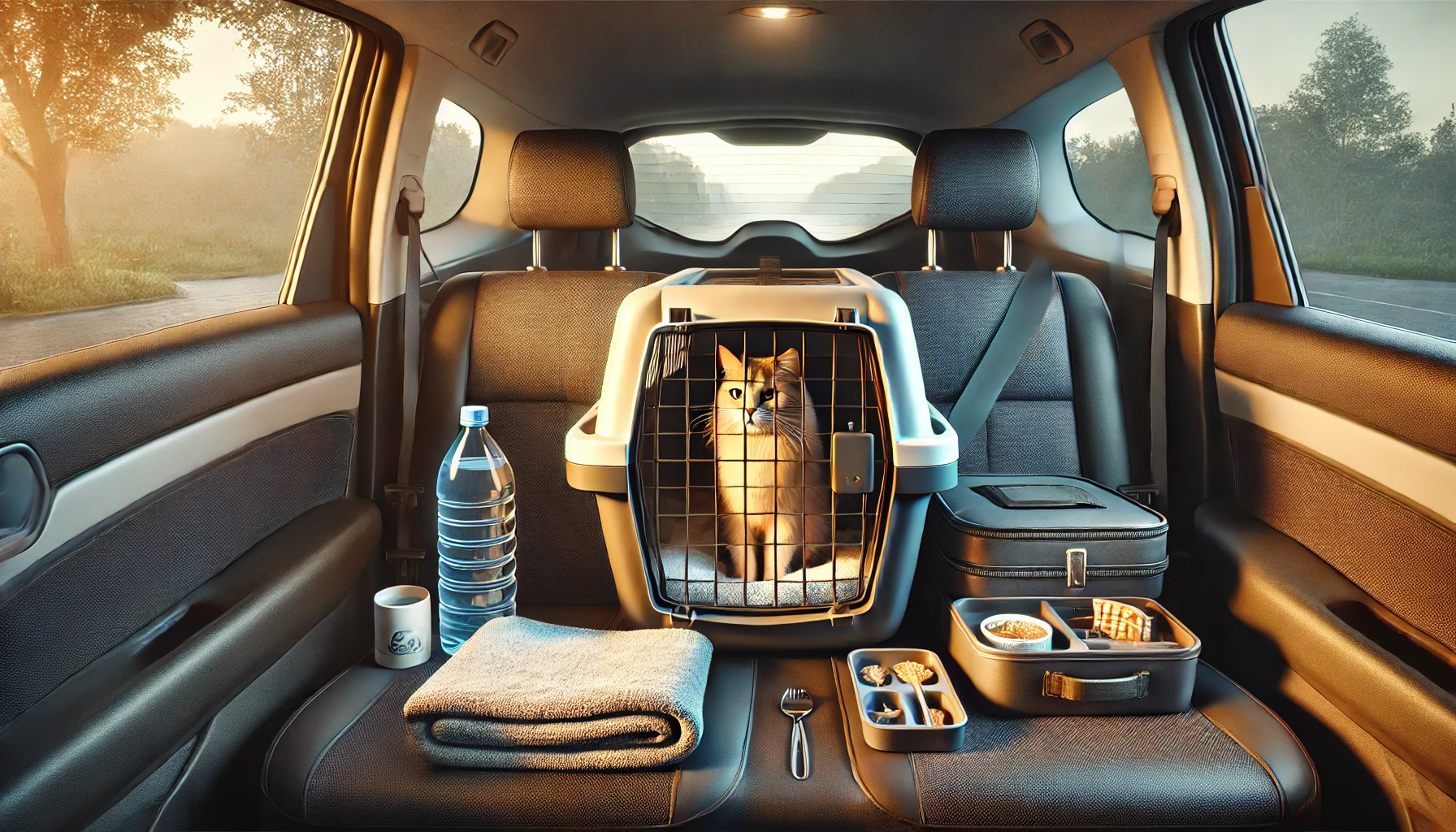
Summary: How to Safely and Comfortably Take Your Cat in the Car
The process of preparing your cat for car travel requires patience, thoughtful planning, and proper technique to ensure your cat’s safety and comfort.
Since the car is an unfamiliar environment, cats are often anxious about it.
With enough preparation and the right training, however, car travel can be comfortable, or at least less distressing, for your feline friend.
This guide has covered key steps and tips for preparing your cat for travel, ensuring their safety, reducing stress in the car, and providing aftercare once you return home.
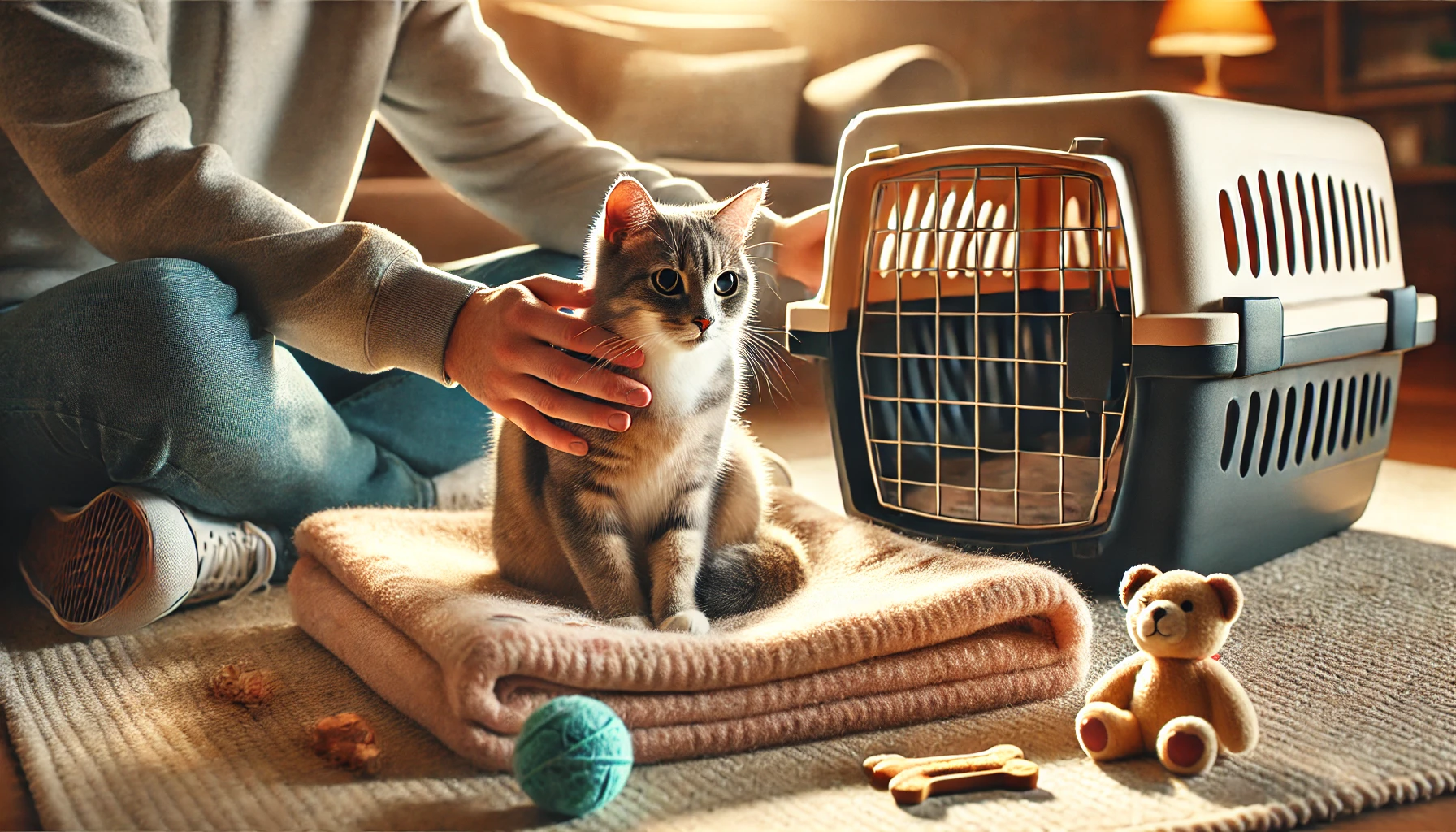
Preparing Your Cat for the Journey
Successful car travel starts at home by preparing your cat.
Choosing the right type of carrier, setting it up comfortably, and familiarizing your cat with it are important first steps.
By helping your cat gradually get used to the carrier and the movement associated with car travel, you set a solid foundation for a stress-free journey.
- Use a secure carrier with proper ventilation and enough space for comfort.
- Introduce the carrier positively by placing it in a familiar area of your home.
- Help your cat become familiar with entering and exiting the carrier using treats, toys, and short practice trips.
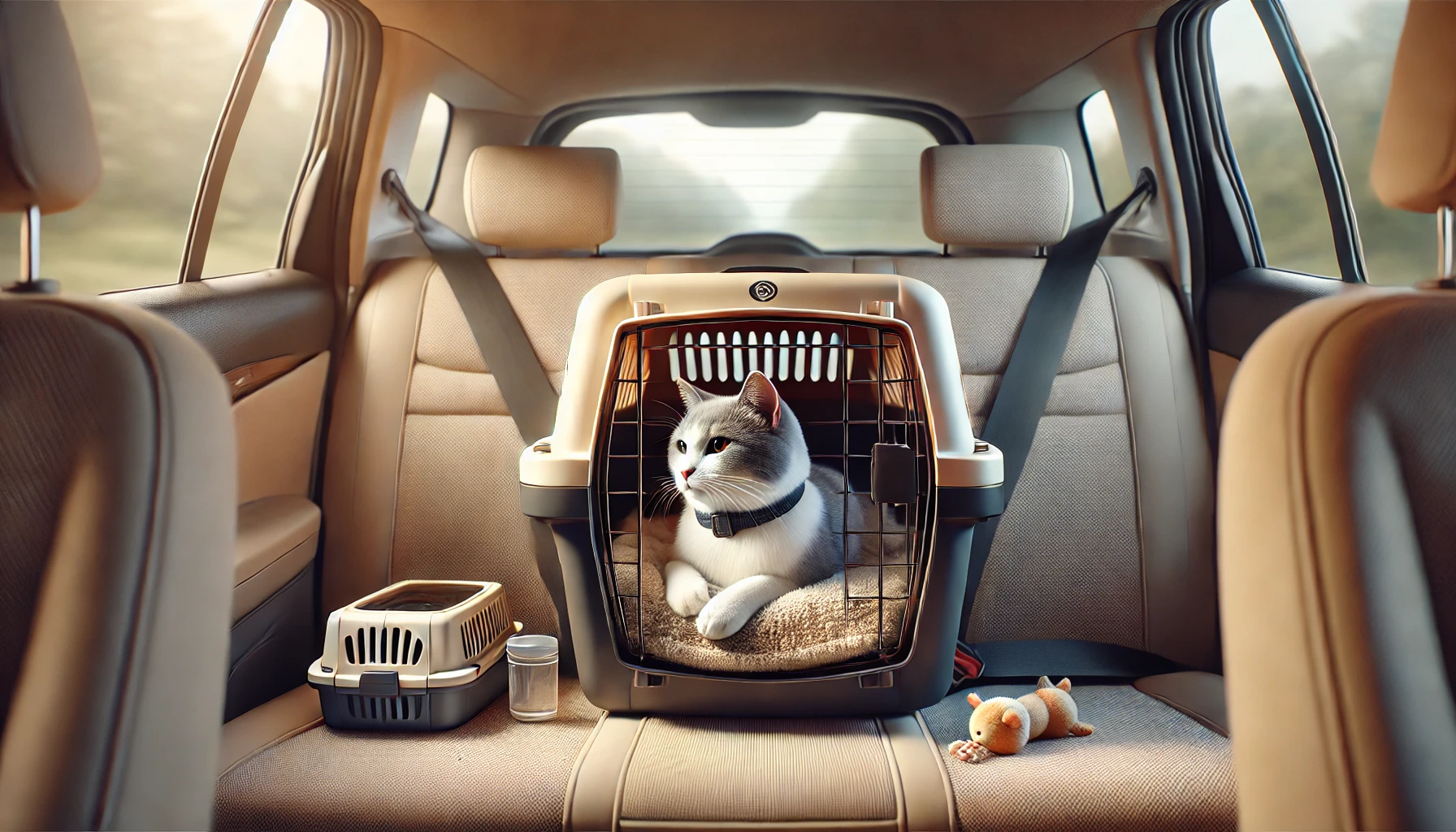
Safety and Comfort During Car Travel
Ensuring safety and comfort for your cat while traveling in the car is crucial.
Secure the carrier properly, maintain a comfortable temperature, and plan for necessary breaks.
By managing the car environment, such as temperature and regular stops, you can keep your cat as calm and comfortable as possible.
- Secure the carrier in the back seat with a seatbelt to prevent movement.
- Keep the car well-ventilated and at a comfortable temperature.
- Make regular stops to offer water and provide a short break outside the carrier.
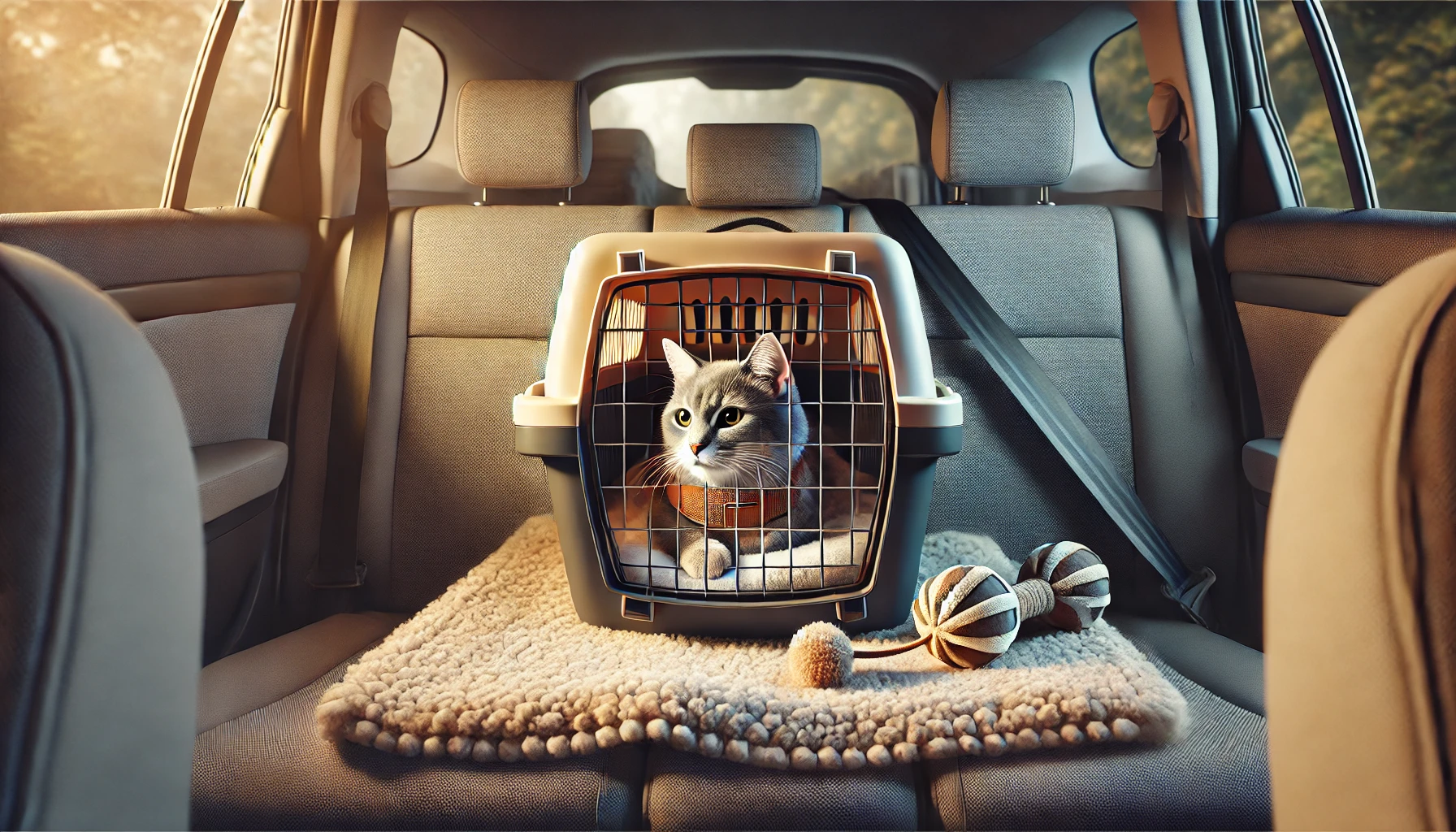
Minimizing Stress and Anxiety
Cats are sensitive to new surroundings and motion, which can make car travel challenging.
Calming aids like pheromone sprays, calming collars, and maintaining low noise levels inside the car can help relieve stress.
By identifying common anxiety-inducing factors and addressing them, you can greatly improve your cat’s travel experience.
- Use pheromone sprays or calming collars for additional comfort during travel.
- Keep the car as quiet and cool as possible to minimize anxiety.
- Take your cat on several short drives before attempting a longer trip.
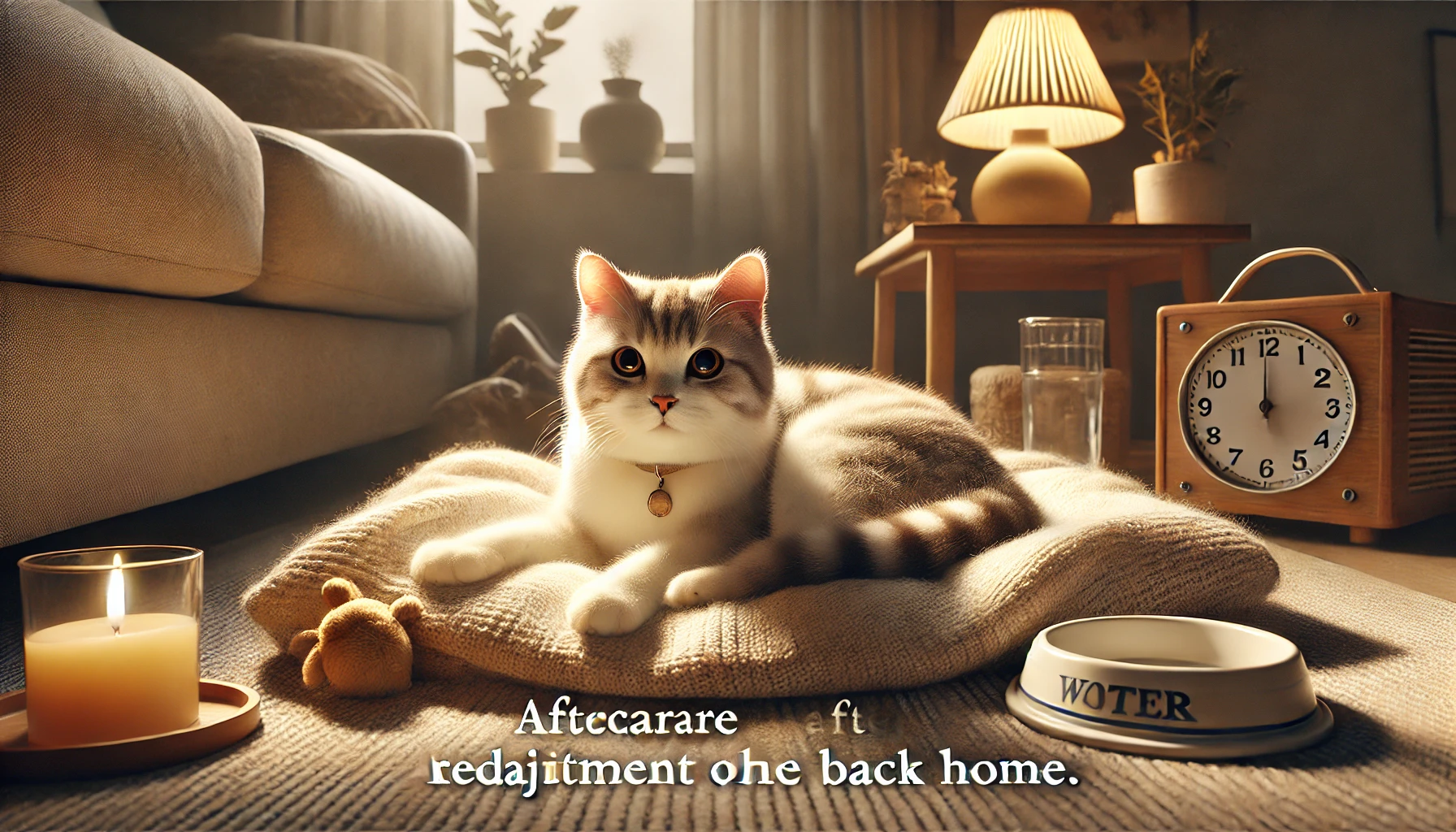
Aftercare: Helping Your Cat Readjust Once Home
Give your cat time to readjust to their home environment after the trip.
Provide access to a quiet room, reward them with treats and gentle praise, and continue to monitor for any lingering signs of stress.
This aftercare will help your cat associate the experience with something positive, making future car travel easier.
- Allow your cat time and space to explore and reacclimate to the home environment at their own pace.
- Reward your cat with treats and praise to create positive associations with travel.
- Watch for signs of stress; if symptoms persist, consult a veterinarian.
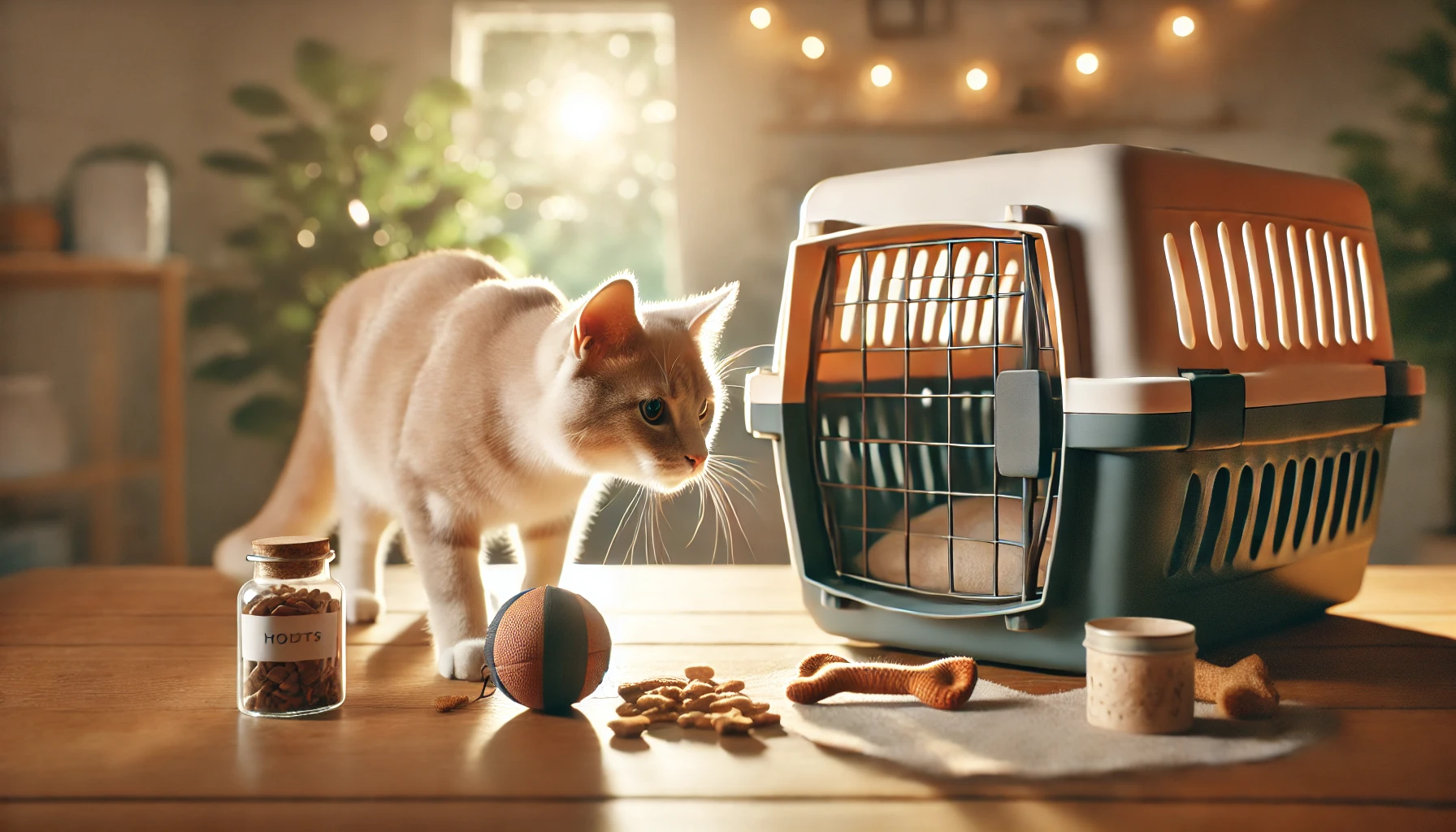
Creating Positive Associations for Future Car Travel
To make future car travel easier, create positive associations with each journey.
Offering rewards, maintaining familiar scents, and gradually reintroducing the car environment over time will help your cat feel more comfortable with travel.
With these practices in place, you’ll be well-prepared for a smooth and enjoyable journey the next time you take your cat on a car trip.
With just a little thoughtful preparation and a few careful adjustments, car travel can become both manageable and enjoyable for you and your cat.
Prioritizing safety, reducing stress, and creating positive experiences will set your feline friend up for a lifetime of comfortable car journeys.
With preparation, patience, and proper safety measures, you can make car travel a manageable and comfortable experience for your cat.
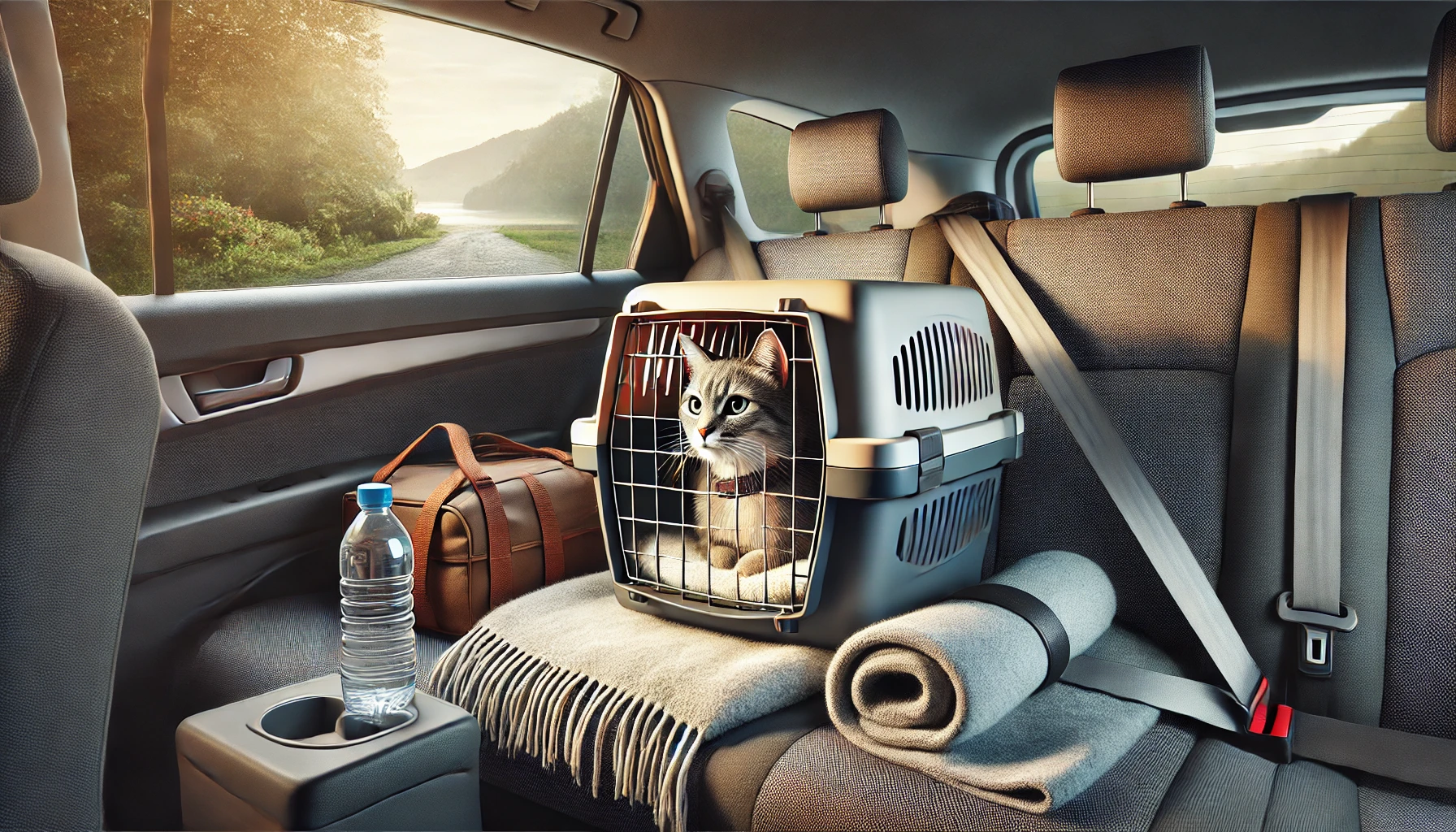
Cat Car Travel Safety: Frequently Asked Questions
Here are some common questions about safely and comfortably traveling with your cat in the car, along with concise answers to guide you through preparation, training, and caring for your cat during car journeys.
How do I prepare my cat for their first car trip?
Get your cat used to the carrier first, use calming aids if needed, and take short practice trips around town to help them adjust to the car without stress.
Is it safe for my cat to be loose in the car?
No, cats should never roam free.
Always secure them in a safe, comfortable, well-ventilated carrier to prevent injury during travel.
What kind of carrier is best for traveling by car with a cat?
A hard-sided carrier with plenty of ventilation and enough space for your cat to sit and turn around comfortably is ideal for safe car travel.
How frequently should I stop on a long car trip with my cat?
Plan to stop every two to three hours to check on your cat, offer water, and give them a short break from the carrier.
Can I use calming sprays to decrease anxiety in cats about travel?
Yes, pheromone calming sprays are non-toxic and effective for helping cats feel comfortable during travel, creating a soothing atmosphere inside the carrier.
Should I feed my cat before going on a car drive?
Feed your cat a light meal a few hours before the trip to reduce the risk of motion sickness, but avoid feeding them heavily right before departure.
How will I know if my cat is stressed during travel?
Signs of travel stress in cats include excessive meowing, panting, hiding, or scratching at the carrier.
Monitor these signs and take breaks if necessary.
How can I make my car comfortable for my cat?
Maintain a quiet, temperature-controlled environment with minimal noise.
Add a familiar blanket or toy in the carrier to comfort your cat.
How long does it take for my cat to settle after travel?
Adjustment times vary, but provide a quiet space and monitor for signs of stress.
Most cats settle within a day or two after travel.

